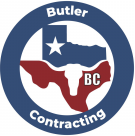Wood that is subject to the elements goes through changes along with the weather extremities. Depending on where you live, the severity of change will differ depending on climate. The type of wood you use may be more preferable in some areas than others, but we at Butler Contracting are focused on building fences to last and endure the hot summers of Central Texas.
What Causes Wood Boards to Expand and Contract?
One thing that causes wood to change is moisture. Wood is really good at absorbing water and can even soak up moisture in the air, which means that if you live in a wet or humid climate, you can guarantee that the wooden pickets on your fence will be affected by it. Another factor is the sun. It’s unlikely that a wood fence will avoid sunlight most of the day, if at all and prolonged exposure to the heat can cause the wood to dry out, crack and splinter.
What Kind of Wood Shrinks the Least?
Pine is notorious for being temperamental and twisting and bowing as it becomes weathered. That’s why you’ll typically see pine fence boards treated with chemicals to make them more resistant to water and UV rays. Treating the wood may prolong the life of the fence, but you’ll still have to deal with the threat of warping or cracking despite being pressure treated. Types of wood that shrink the least will depend on the climate you live in, but generally cedar and redwood are naturally most resistant to change. You should check with your local fence builder to see what they recommend, the type of material you choose could greatly affect how long the fence lasts and how much maintenance it will need over that time.
What Can I Do To Reduce Fence Boards From Shrinking?
If you build a wood fence, you’ll want to think about staining, sealing, or painting the fence. Either of these options is going to help minimize the amount of water and moisture that the wood boards absorb. Sealant can also provide a bit of UV protection. While there’s no complete solution to the problem, staining, sealing, or painting will help extend the life of the fence and will reduce the amount of twisting and bowing that occurs.
All three of those options will also require regular maintenance in order to continue reaping the benefits they have for your fence. You’ll need to continue to stain your fence or seal every few years or so. With that maintenance also comes washing your fence before you put on a new coat of stain, sealant or paint.
Try to keep your sprinkler or hose away from the wood to minimize the absorption. The fence will get wet one way or the other, but it’s best not to keep water away from your fence if possible.
Use the correct nails! If you’re going to use nails, make sure that they are stainless steel ring shank nails. The rings keep the nails from getting worked out as the boards twist and move over time. If you’d like to know more about these nails and when to use them instead of screws, check out our blog article Nails Vs Screws for Your Fence.
Other Fence Options
If you’re not completely set on a wood fence, there are other options that you can look into that don’t run the risk of warping and bending, such as wrought iron, ornamental iron, chain link, or vinyl.

You can also consider Butler’s Own “Mina” fence. We designed a fence that features 5-inch treated round posts, which are more durable than 4x4s that are prone to warping, bowing, and cracking. They are also more aesthetic than metal posts. The Mina style fence features three rows of true 1-inch thick treated boards with an optional top cap placed horizontally for less warping and provides greater durability for resisting weather, animals, and gravity. This fence is a hybrid made of wood but also features galvanized and black vinyl-coated chain link steel.
The treated boards will warp less and because they are oriented horizontally, if you ever need to replace them for any reason, you will need far fewer of them than you would vertically oriented pickets. The Mina style is a great no-climb fence that is perfect for keeping in your curious kids and animals.
Have Butler Contracting Build Your Fence!
Let’s face it: a lot can go wrong with building a fence so save yourself the headache and call the experts. We can help you determine what fence options best suit your needs. You can use our Fence Estimator Tool on our website to start your planning or give us a call and talk to us directly at (844) 628-8537



